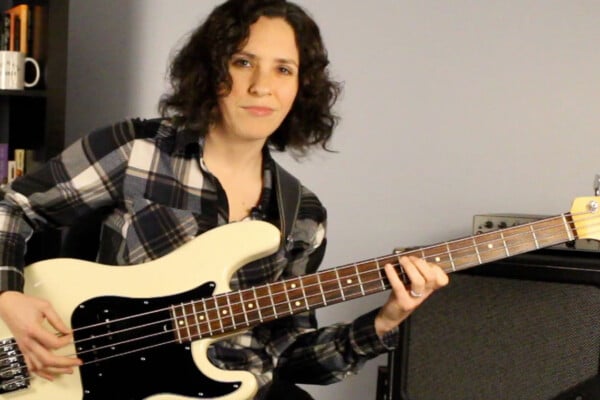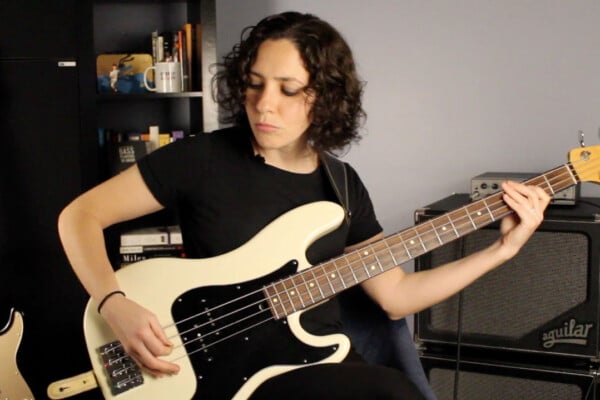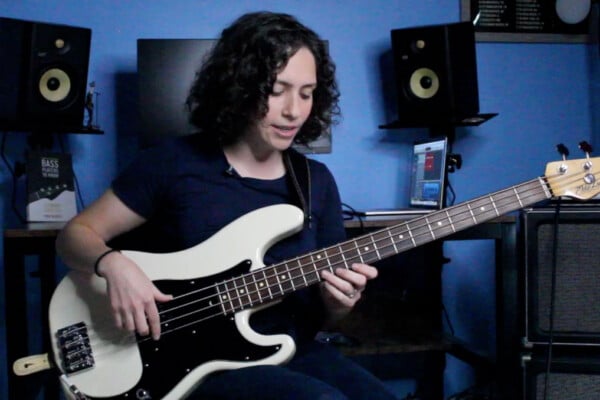Untold Secret to Melodic Bass lesson: Using Dynamics in Bass Lines
Internal Dynamics is an area that seems to be largely ignored in the teaching of Jazz, while at the same time is one of the most essential components of “swing.” Accents and phrasing are essential; music that is played without this awareness is flat and monotonous, and people who are playing without employing knowledge of these tools are usually destructive to the music.
There is a lot of misinformation, confusion, and toxic pedagogy with regard to swing, accents, phrasing, and how they work together. Two of the most abused and misunderstood concepts are “laying back” and “back-phrasing,” and we will touch on these as we go along. Swing depends on a constant underlying pulse, and tension and release against the underlying pulse (pulling against the tempo) is a parameter available to the performer; however, there is vast opportunity to create tension and release within the pulse—without “violating the tempo stream”—that is much more powerful and effective. The problem comes when performers do the former without an understanding of the latter. The underlying substrate of swing is triplets, and there are many things that can be done, many traditions of development with triplets; different groupings, accent patterns, overlays, and offsets of the triplet stream.
The greatest horn players I’ve heard can “lock in” a rhythm section with a few notes; Clark Terry and Houston Person come immediately to mind, although there are many greats—Miles, Wayne, Trane, Freddie, Wynton, Frank Sinatra, etc. etc.; who put the rhythm is where it is supposed to be; right with the rhythm section (or, sometimes, where they intend the rhythm section to be playing it!). Their playing sounds free and “laid back” because of their ability to recompose the rhythm with the use of devices such as eighth note triplets offset by a triplet eighth note, or a series of quarter notes with a similar offset, or many other possible rhythmic devices:

Upon trying to write an example of what NOT to do—drag the tempo, or back-phrase so far that the relationship between melody and harmony is broken—I found that as soon as it was written, it looks like “actual music.” It’s difficult to make nice engraving look like something that sounds bad… although, many nice engravings do indeed sound bad.
There are rich traditions in rhythm that have been passed down orally; musicians with “ears” or “talent” seem to soak some of these principles up by osmosis. Playing rhythmically and using dynamic contrast can be great fun for the player, and rhythmic expressiveness is a hallmark of dynamic performance that should be a point of strong focus.
The Substrate of Swing
There is an underlying structure to swing:

There are traditional accent locations in the substrate, as you can see above.
Whenever there is an accent, there is an increased investment of energy in the playing of it. For natural contrast, accents are usually followed by un-accented material, requiring a different touch and investment of energy. There is some “recovery time” required; the player needs to restrain himself and “let go” following the creation of the accent; this contrast between the investment of energy and the subsequent “letting go” creates “feel,” and transmits very directly into the listener.
There can be different layers of accents occurring at the same time. As you can see in the example above, the last eighth note of each triplet gets an accent, while simultaneously there is a larger accent on 2 and slightly less on 4, with a big accent on 3 of the fourth bar… this is not a rigid prescription, but only a suggestion for an interpretation of style, but when compared to a featureless un-accented recitation of the same rhythms, it has a much greater sense of swing. It has “feel,” and character, and sounds great! It breathes, and has life. It is a good idea to use various overlays to vary the accent scheme; the examples thus far have all incorporated the accent scheme just described; at times, though, accenting all notes, or un-accenting all notes, for some period, produces an interesting effect. Also, reversing where the primary accents fall—making 4 the bigger accent, for example—is a good change of pace. The objective is to become aware of the power of accents, and to be able to use them intentionally to create a desired effect.
Every jazz drummer has a characteristic and individual “ride beat” (although there are some who have the capacity to vary their beat according to the style). The characteristic “feel” comes from:
- Which notes are accented? Some accent all the downbeats; some accent two and four; some accent the triplet upbeats; this parameter is also a factor in the style of a particular period.
- Whether the accent pattern is regular or varied; some play the exact same feel all the time; some styles depend on a certain array of accents, but the better drummers know how to “break it up” and create phrasing with the construction of their ride beat, in any style.
- How hard the accent is hit
- How quick is the recovery time? How close is the triplet upbeat to the following downbeat?
These are all factors that come together in an individual and create an individual style. The greatest musicians are aware of all these parameters and are able to come up with an appropriate “feel” for a particular band. Everybody in the band needs to have some awareness of these parameters; when a band is not playing together, it is usually from inflexibility, lack of awareness, or disagreements on this issue. Some drummers believe—or have been taught—that they are “the time-keeper,” and will not accommodate any other feel. Some people learn a particular style, and are not aware how that style may be related to others, or what the elements of the style of those around them might be. The ability to accommodate differences in style (and inflexible and didactic drummers!) is vital indeed for a bass player.
There are also horn players and singers who have not learned the fundamentals of rhythm, and are not aware of their responsibility to become one with the rhythm section. Although they might believe they are making a powerful statement, or getting a lot of “feeling,” if they are abusing the tempo stream, they are making the audience—and the rhythm section’s —skin crawl. Back-phrasing must NOT be another word for “dragging the tempo!” Back-phrasing should be: the active re-composition of the melody by affirmatively performing alternative rhythms within the rhythmic stream.
The much-touted practice of “laying back” is another minefield of misunderstanding. Count Basie’s Band had a distinctive sound, a very powerful swing, and many described their rhythmic style as “laying back,” and there have been millions of attempts to emulate the feel. The common, toxic misconception is that the “feel” of the band is created by “laying back” on the offbeats; this interpretation of “laying back” is pervasive and leads many brass and sax sections to drag the tempo; if this is what “laying back” is taken to mean, it should stop immediately! Dragging the tempo does NOT create swing!! It’s only a sign of rhythmic ignorance; sometimes it’s mob ignorance when a whole band is following an ignorant lead trumpet player.
In actuality, a close listen and careful analysis of the Basie style will show that the offbeats are accented, and early… creating a feel of “settling” on the downbeats. Those who would “lay back” should investigate this concept—the offbeats are early to allow recovery time from the energy invested in the accent—and then the band “sits on” the downbeats… or, more accurately, the downbeats are where they occur in the stream… on time.
There is one particular figure I’ve heard Basie’s Band play many times; and they have a unique way of interpreting the figure. The figure is the last 3 eighth notes of the bar:

Ex. 36 above is how I’ve heard them play it; it’s an evolved consensus, an oral tradition in the band that this is how the figure is played.
This is an example of “back-phrasing” by actively re-composing the rhythm—and also an example of the oral transmission of culture; never mind what the paper says; this is how we play that figure. I haven’t heard the band lately; I don’t know if this is still in practice, but this is what they were doing in the early 80s when I had the chance to play with the band while working with Tony Bennett.
There is another way to look at and define “laying back,” which would involve placing the accented offbeats closer to the following downbeat, necessitating a faster recovery time. Yes, we can do anything we want, interpretively; but does it swing? There is a distinctive effect created by delaying the offbeats, but the resulting feel has more tension in it because of the sheer energy required for the fast recovery time to the next downbeat. Too often, horn players or singers use this effect without regard for the burden it places upon those living on the downbeats, namely the rhythm section. The masters of this effect will exemplify the feel of the “groove” (Groove: the ongoing “feel” of the time as created by the use of internal dynamics, phrasing, timing, and the relationship between anchors and pivots in the bass) by incorporating downbeats into their phrasing as well, thereby illustrating the feel of the groove they’re trying to create. Too often, those ‘laying back” do so without an apparent regard for the groove as a whole and without providing references in their phrasing to the following downbeats.



